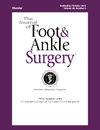Return to sport activity after osteochondral lesion of the talus treated with arthroscopic autologous matrix-induced chondrogenesis
IF 1.3
4区 医学
Q2 Medicine
引用次数: 0
Abstract
The talar dome is a common site for osteochondral lesions, usually due to past trauma.
Non-operative treatment leads to clinical improvement in less than half of the patients; moreover, in many cases, it does not facilitate a return to previous sporting activities.
The aim of this retrospective study is to evaluate the return to sports activities of patients with osteochondral lesions of the talus larger than 1.5 cm2)who have undergone treatment using the arthroscopic Autologous Matrix-Induced Chondrogenesis technique at least 18 months after surgery.
A total of 61 consecutive patients who were younger than 55 years old at the time of surgery and regularly engaged in sports activities were included in the study.
The clinical assessment was performed with physical examination, the American Orthopedic Foot & Ankle Society ankle score, the visual analogue scale, and the Tegner activity scale before surgery and at the time of follow-up.
Among the patients evaluated, 27 patients (44 %) returned to their main sport, while 34 patients (56 %) couldn’t resume their previous sports activities. Of these, 6 patients (9.8 %) abandoned sports activities altogether. The American Orthopedic Foot & Ankle Society ankle score and visual analogue scale showed a statistically significant increase between pre- and post-surgery, while a statistically significant decrease in the Tegner score was recorded.
The arthroscopic Autologous Matrix-Induced Chondrogenesis technique effectively treated osteochondral lesions, reducing pain and improving tibio-tarsal function, even in non-professional athletes, allowing a return to daily and non-competitive sports activities.
关节镜下自体基质诱导软骨形成治疗距骨软骨病变后恢复运动。
距骨穹窿是骨软骨病变的常见部位,通常是由于过去的创伤。非手术治疗导致临床改善的患者不到一半;此外,在许多情况下,它并不有助于恢复以前的体育活动。本回顾性研究的目的是评估距骨软骨病变大于1.5 cm2的患者术后至少18个月接受关节镜自体基质诱导软骨形成技术治疗后恢复体育活动的情况。共有61例患者在手术时年龄小于55岁,并经常参加体育活动。术前及随访时采用体格检查、美国骨科足踝学会踝关节评分、视觉模拟量表、Tegner活动量表进行临床评估。27例(44%)患者恢复主要运动,34例(56%)患者不能恢复原来的运动。其中6例(9.8%)完全放弃体育活动。美国骨科足踝协会踝关节评分和视觉模拟量表显示术前和术后有统计学意义的升高,而Tegner评分有统计学意义的降低。关节镜下自体基质诱导软骨形成技术可有效治疗骨软骨病变,减轻疼痛,改善胫跖功能,甚至对非专业运动员也是如此,使其能够恢复日常和非竞争性体育活动。
本文章由计算机程序翻译,如有差异,请以英文原文为准。
求助全文
约1分钟内获得全文
求助全文
来源期刊

Journal of Foot & Ankle Surgery
ORTHOPEDICS-SURGERY
CiteScore
2.30
自引率
7.70%
发文量
234
审稿时长
29.8 weeks
期刊介绍:
The Journal of Foot & Ankle Surgery is the leading source for original, clinically-focused articles on the surgical and medical management of the foot and ankle. Each bi-monthly, peer-reviewed issue addresses relevant topics to the profession, such as: adult reconstruction of the forefoot; adult reconstruction of the hindfoot and ankle; diabetes; medicine/rheumatology; pediatrics; research; sports medicine; trauma; and tumors.
 求助内容:
求助内容: 应助结果提醒方式:
应助结果提醒方式:


